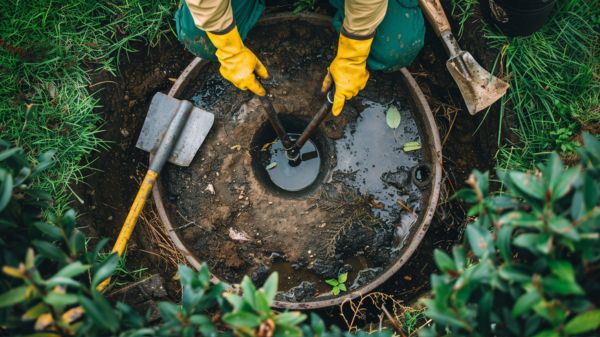Identifying and troubleshooting septic tank problems involves recognizing signs like standing water, foul odors, slow drains, and sewage backups. Tree roots can infiltrate and compromise the system, requiring regular inspections and preventive measures.
Early detection of drainfield issues is vital, including foul odors, slow drainage, and wet areas above the field. Promptly address sewage backups by identifying causes like blockages or tank malfunctions. Strong septic odors indicate potential plumbing issues or leaks, necessitating immediate action.
Using natural products helps maintain system health, while fixing standing water requires inspection and preventive measures. Prevent costly repairs with proactive maintenance and proper disposal practices. This thorough approach ensures the longevity and efficiency of your septic system.
Key Takeaways
- Look for standing water, foul odors, slow drains, gurgling sounds, and sewage backups.
- Regularly inspect for tree root intrusion to prevent septic system damage.
- Watch for foul odors, slow drainage, and soggy ground to detect drainfield issues early.
- Address sewage backup causes promptly to prevent property damage and health risks.
- Use natural products to maintain septic system health and avoid chemical damage.
Common Signs of Septic Tank Issues
Often, the early detection of septic tank issues is crucial in avoiding extensive damage and costly repairs. Signs indicating potential problems include standing water near the septic tank, which can suggest system malfunctions.
Foul odors near the tank or inside the house are also red flags that should not be ignored. Slow drains are another common early warning sign that could point to underlying septic tank issues. If accompanied by gurgling sounds in plumbing fixtures, slow drains may indicate a need for further inspection.
Additionally, sewage backups, such as toilet overflows or sewage rising through drains, are clear indicators of septic tank problems that require immediate attention. Recognizing these signs promptly can help homeowners address septic tank issues before they escalate into more severe and costly repairs.
Impact of Tree Roots on Septic Systems
Tree roots pose a significant threat to septic systems by infiltrating and causing damage to essential components such as pipes, tanks, and drain fields.
- Tree roots can infiltrate septic system components, leading to blockages, leaks, and structural issues within the system.
- Invasive tree roots can compromise the integrity of the septic system, resulting in costly repairs.
- Planting trees at a vital distance from the septic system is essential to prevent root intrusion and subsequent damage.
- Regular inspections for tree root encroachment and implementing preventive measures can help avoid extensive damage and maintain the system’s functionality.
To safeguard your septic system from tree root damage, consult professionals for guidance on suitable tree planting distances. By taking proactive measures, such as monitoring root growth and implementing preventative strategies, homeowners can mitigate the risk of root infiltration and preserve the integrity of their septic systems.
Detecting Drainfield Failure Early
Early detection of drainfield failure is vital in maintaining septic system functionality. Signs such as foul odors near the drainfield, slow drainage in plumbing fixtures, and wet or soggy ground above the drainfield can serve as red flags.
Foul Odors Near Drainfield
To efficiently detect potential drainfield failure early, vigilant monitoring for foul odors near the drainfield is imperative.
- Early Warning Signs: Foul odors can be an initial indication of underlying issues.
- Causes of Odors: Septic tank overflows, clogs in drainfield pipes, or system malfunctions may be the culprits.
- Preventive Measures: Prompt action upon detecting odors is essential to prevent further damage.
- Professional Assistance: Seeking expert help can accurately diagnose problems and make appropriate repairs swiftly.
Vigilance in recognizing foul odors near the drainfield can help mitigate costly repairs and environmental hazards associated with septic system malfunctions. Regular inspections and swift intervention play an essential role in maintaining the efficiency of the septic system.
Slow Draining Fixtures
Detecting drainfield failure early is essential in maintaining the functionality and longevity of a septic system. Slow draining fixtures can serve as an important early warning sign of potential septic system failure. This issue, often caused by clogs, hydraulic overloading, or drainfield pipe blockages, should not be ignored.
Addressing slow drains promptly is critical to prevent more severe problems like backups and sewage leaks. Regular monitoring of drain performance is necessary for identifying and resolving drainfield issues before they escalate.
| Common Causes of Slow Drains | Potential Consequences |
|---|---|
| Clogs | Backups and sewage leaks |
| Hydraulic Overloading | Drainfield failure |
| Pipe Blockages | Compromised septic system |
| Costly repairs |
Wet or Soggy Ground
Addressing signs of wet or soggy ground around the drainfield is essential in identifying potential drainfield failure and preventing more severe septic tank issues.
- Excess water pooling can be a sign of septic system issues that need attention.
- Standing water near the drainfield may point to drainage problems within the septic system.
- Drainfield failure can lead to waterlogged soil and potential sewage backups.
- Detecting and addressing wet or soggy ground early can prevent more significant septic tank problems.
Dealing With Sewage Backup Problems
Identifying sewage backup problems requires a systematic approach to pinpoint the root causes and implement effective solutions promptly. Understanding the potential sources of backup, such as septic tank issues or blockages, is essential for targeted troubleshooting.
Backup Causes
The occurrence of sewage backup in a property’s drainage system can stem from various factors, such as a full or obstructed septic tank, significant blockages within drain lines, or malfunctions in tank components.
- A full or clogged septic tank
- Major blockages in drain lines
- Malfunctioning tank devices
- Severe sewage backup
When faced with sewage backing up through drains connected to the septic system, immediate action is important. For severe cases, seeking professional help is advised to address the issue effectively. It is important to be aware of the health risks associated with sewage backup and take prompt measures to prevent further damage to the septic system and property.
Backup Solutions
To effectively manage sewage backup issues in a property’s drainage system, prompt and strategic intervention is vital. When faced with sewage backup, it is essential to address the root cause promptly to prevent health hazards and property damage. Common causes such as clogged septic tanks, blockages in drain lines, or malfunctioning tank devices can lead to such problems.
Seeking professional help is highly recommended, especially in severe cases, to guarantee a safe and effective resolution. Immediate action is necessary to mitigate the risks associated with sewage backup, including contamination and health concerns.
In instances of significant sewage backup, contacting home insurance and refraining from handling items exposed to raw sewage can prevent further complications and ensure a thorough cleanup process.
Addressing Strong Septic Odors
Strong septic odors, particularly those reminiscent of rotten eggs, serve as important warning signs of potential septic system complications that necessitate immediate attention and resolution.
When addressing strong septic odors, consider the following:
- Indoor Odors: These may indicate sewage backup into drains, highlighting a potential issue within the plumbing system.
- Outdoor Odors: Odors near the septic tank or drain field often stem from sewage leaks, requiring investigation to prevent further seepage.
- Causes of Odors: Various factors such as an overwhelmed system, broken pipes, tank cracks, tree root intrusion, or shifting soil can contribute to foul smells.
- Smoke Test: Utilizing a smoke test can help pinpoint leaks causing persistent odors, aiding in the prompt identification and repair of septic system issues.
Addressing strong septic odors promptly is essential to avoid health risks, environmental harm, property damage, and legal consequences. By identifying and resolving the root cause of these odors, you can prevent more significant septic system malfunctions down the line.
Troubleshooting Slow Drain Issues
When experiencing slow drain issues in a septic system, identifying the underlying causes is essential for effective troubleshooting and maintenance. Slow drains are often a result of pipe blockages within the septic system, leading to water backup problems.
It is important to avoid using harsh chemical drain cleaners, as they can cause further damage to the septic tank and pipes. Instead, opting for natural products containing beneficial bacteria and enzymes can help break down clogs in the system without harming the essential microbial balance.
Preserving the good enzymes and bacteria in the septic tank is critical for maintaining a healthy septic system and preventing slow drain issues. To prevent such problems, it is advisable to keep pipes clear of non-biodegradable items and utilize septic-safe products that support the natural processes within the system.

Strategies for Fixing Standing Water Problems
Addressing standing water problems in a septic system requires a thorough assessment of potential causes and the implementation of targeted solutions to restore proper functionality. When dealing with standing water issues in a septic system, consider the following strategies:
- Inspect the Septic Tank: Check for signs of overflow or blockages that may be causing the standing water.
- Evaluate the Drain Field: Look for pooling water near the drain field, which could indicate issues like compacted soil or pipe blockages.
- Pump Out the System: If standing water persists, consider pumping out the septic tank to alleviate any potential overflow problems.
- Address Drainage Concerns: Ensure proper drainage around the septic system to prevent standing water issues from reoccurring.
Regular maintenance and preventive measures are essential for keeping your septic system in peak condition and avoiding costly repairs due to standing water problems. By taking proactive steps to address these issues, you can ensure the efficient operation of your septic tank and prevent potential overflow situations.
Preventing Costly Septic System Repairs
To prevent costly septic system repairs, implementing proactive maintenance measures and adhering to proper disposal practices can greatly reduce the risk of expensive damages. Regular maintenance, including the use of biological additives like DOWN JOHN™ Treatment, is important for the health of septic systems.
These additives help maintain the balance of bacteria in the tank, enhancing its functionality and preventing the need for costly repairs. Proper disposal of non-biodegradable items is also essential in avoiding clogs and blockages that could lead to expensive fixes.
Water conservation practices can further prevent system overload and potential damage, ultimately saving on repair costs. Timely inspections and proactive measures play an essential role in catching minor issues before they escalate into major problems, reducing the likelihood of expensive repairs.
By investing in preventive treatments and routine maintenance, homeowners can greatly decrease the risk of facing costly septic system repairs, ensuring the longevity and efficiency of their systems.
Frequently Asked Questions
How Do You Tell if the Leach Field Is Clogged?
Signs of a clogged leach field include standing water, slow drainage, foul odors, and unusually green grass. Leach field maintenance, such as regular inspections, can prevent issues. Professional inspections and DIY solutions are available for troubleshooting and resolving clogs.
What Is the Most Common Cause of Septic Tank Failure?
The most common cause of septic tank failure is hydraulic overload, which leads to backups, odors, and system malfunctions. Neglecting maintenance, root intrusion, tank damage, and bacterial imbalance can exacerbate issues, impacting the drain field’s functionality.
Is My Septic Tank Full or Clogged?
Determining the status of your septic tank requires inspection to ascertain if it’s full or clogged. Regular pumping every 3-5 years prevents issues. Focus on prevention through monitoring water usage, odor detection, drain line maintenance, and avoiding overflows.
How to Fix a Slow Draining Septic Tank?
To address slow draining septic tanks, consider drainage solutions like clearing blockages with hot water, baking soda, vinegar, or a drain snake. Regular tank maintenance can prevent system backup and odors. Seek professional help for persistent issues.
Conclusion
To sum up, identifying and troubleshooting septic tank problems is vital for maintaining the functionality of the system and preventing costly repairs.
By being aware of common signs of issues, monitoring the impact of tree roots, detecting drainfield failure early, dealing with sewage backup problems, addressing strong septic odors, troubleshooting slow drain issues, and implementing strategies for fixing standing water problems, homeowners can guarantee the longevity and efficiency of their septic systems.




